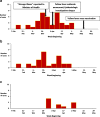Outbreak of yellow fever in central and southwestern Uganda, February-may 2016
- PMID: 30390621
- PMCID: PMC6215607
- DOI: 10.1186/s12879-018-3440-y
Outbreak of yellow fever in central and southwestern Uganda, February-may 2016
Abstract
Background: On 28 March, 2016, the Ministry of Health received a report on three deaths from an unknown disease characterized by fever, jaundice, and hemorrhage which occurred within a one-month period in the same family in central Uganda. We started an investigation to determine its nature and scope, identify risk factors, and to recommend eventually control measures for future prevention.
Methods: We defined a probable case as onset of unexplained fever plus ≥1 of the following unexplained symptoms: jaundice, unexplained bleeding, or liver function abnormalities. A confirmed case was a probable case with IgM or PCR positivity for yellow fever. We reviewed medical records and conducted active community case-finding. In a case-control study, we compared risk factors between case-patients and asymptomatic control-persons, frequency-matched by age, sex, and village. We used multivariate conditional logistic regression to evaluate risk factors. We also conducted entomological studies and environmental assessments.
Results: From February to May, we identified 42 case-persons (35 probable and seven confirmed), of whom 14 (33%) died. The attack rate (AR) was 2.6/100,000 for all affected districts, and highest in Masaka District (AR = 6.0/100,000). Men (AR = 4.0/100,000) were more affected than women (AR = 1.1/100,000) (p = 0.00016). Persons aged 30-39 years (AR = 14/100,000) were the most affected. Only 32 case-patients and 128 controls were used in the case control study. Twenty three case-persons (72%) and 32 control-persons (25%) farmed in swampy areas (ORadj = 7.5; 95%CI = 2.3-24); 20 case-patients (63%) and 32 control-persons (25%) who farmed reported presence of monkeys in agriculture fields (ORadj = 3.1, 95%CI = 1.1-8.6); and 20 case-patients (63%) and 35 control-persons (27%) farmed in forest areas (ORadj = 3.2; 95%CI = 0.93-11). No study participants reported yellow fever vaccination. Sylvatic monkeys and Aedes mosquitoes were identified in the nearby forest areas.
Conclusion: This yellow fever outbreak was likely sylvatic and transmitted to a susceptible population probably by mosquito bites during farming in forest and swampy areas. A reactive vaccination campaign was conducted in the affected districts after the outbreak. We recommended introduction of yellow fever vaccine into the routine Uganda National Expanded Program on Immunization and enhanced yellow fever surveillance.
Keywords: Outbreak investigation; Uganda; Yellow fever.
Conflict of interest statement
Ethics approval and consent to participate
The MoH of Uganda gave the directive and approval to investigate this outbreak. This activity was reviewed in accordance with CDC human research protection procedures and was determined to be non-research, disease control activity. Verbal informed consent (approved by CDC human protection unit) was obtained from the subjects or caretakers/next of kin of the deceased case-persons in the study.
Consent for publication
Not applicable.
Competing interests
The authors declare that they have no competing interests.
Publisher’s Note
Springer Nature remains neutral with regard to jurisdictional claims in published maps and institutional affiliations.
Figures


References
-
- David LH. Control of Communicable Diseases Manual. 20th ed: APHA PRESS; 2014. ed . C.o.C.D
-
- Areas with Risk of Yellow fever Virus Transmittion in Africa and South America. https://www.cdc.gov/yellowfever/maps/index.html. Accessed 22 Oct 2018.
-
- WHO, Yellow fever Fact sheet: http://www.who.int/mediacentre/factsheets/fs100/en/.Accessed on 29 May 2016.
-
- CDC. Global Health Security Agenda https://www.cdc.gov/globalhealth/security/index.htm. Accessed 14 Sept 2017.
-
- WHO, Situation report | Yellow fever outbreak in Angola. (2016). http://www.who.int/emergencies/yellow-fever/situation-reports/04-july-20.... Accessed 4 July 2016.
MeSH terms
Grants and funding
- 001/WHO_/World Health Organization/International
- GH001353-01/President's Emergency Plan for AIDS Relief (PEPFAR) through the US Centers for Disease Control and Prevention Cooperative Agreement number GH001353-01 through Makerere University School of Public Health to the Uganda Public Health Fellowship Program, MoH
LinkOut - more resources
Full Text Sources
Research Materials

